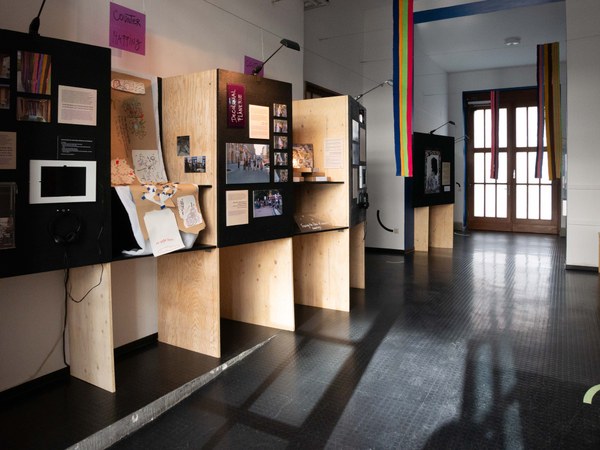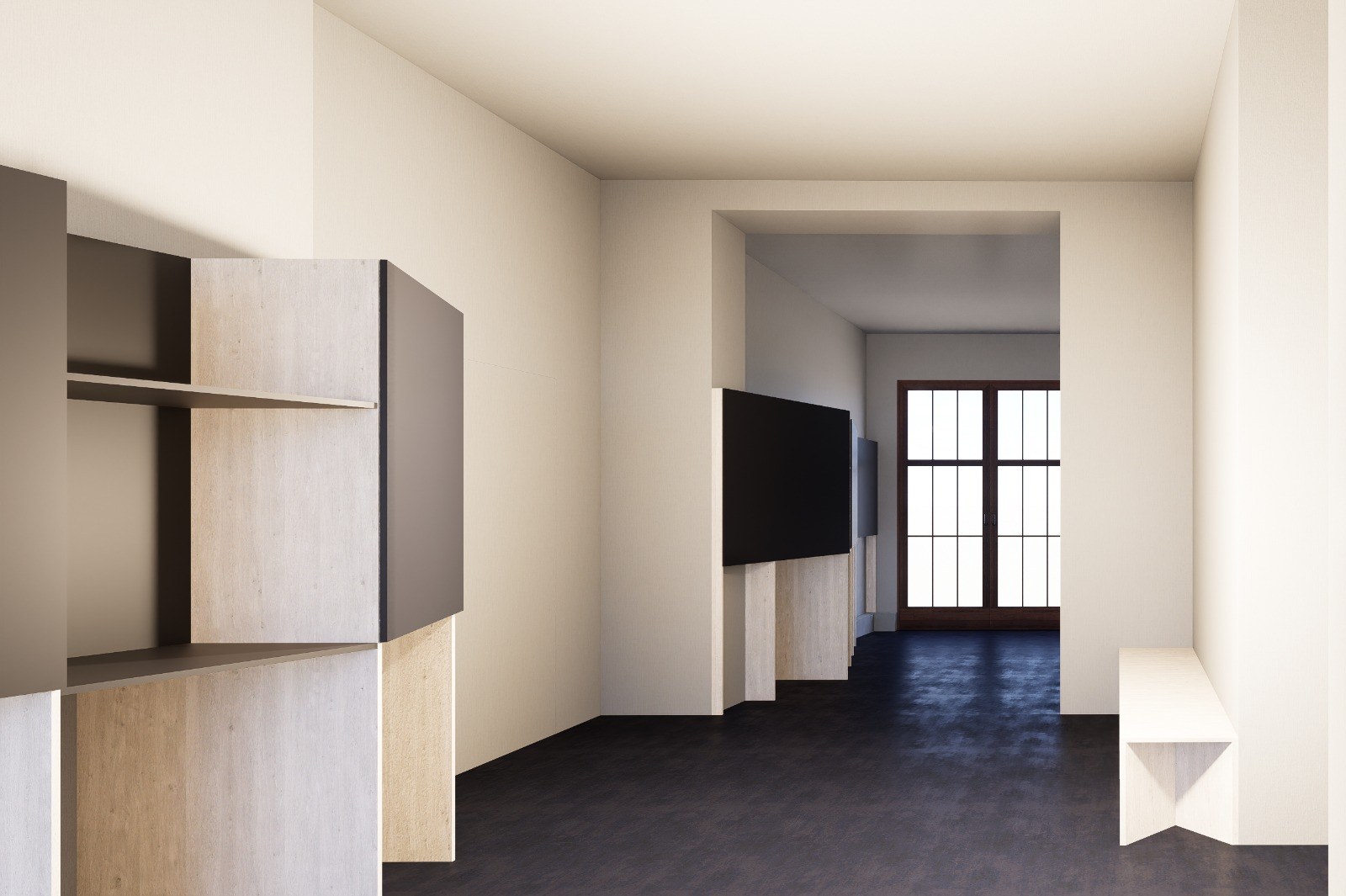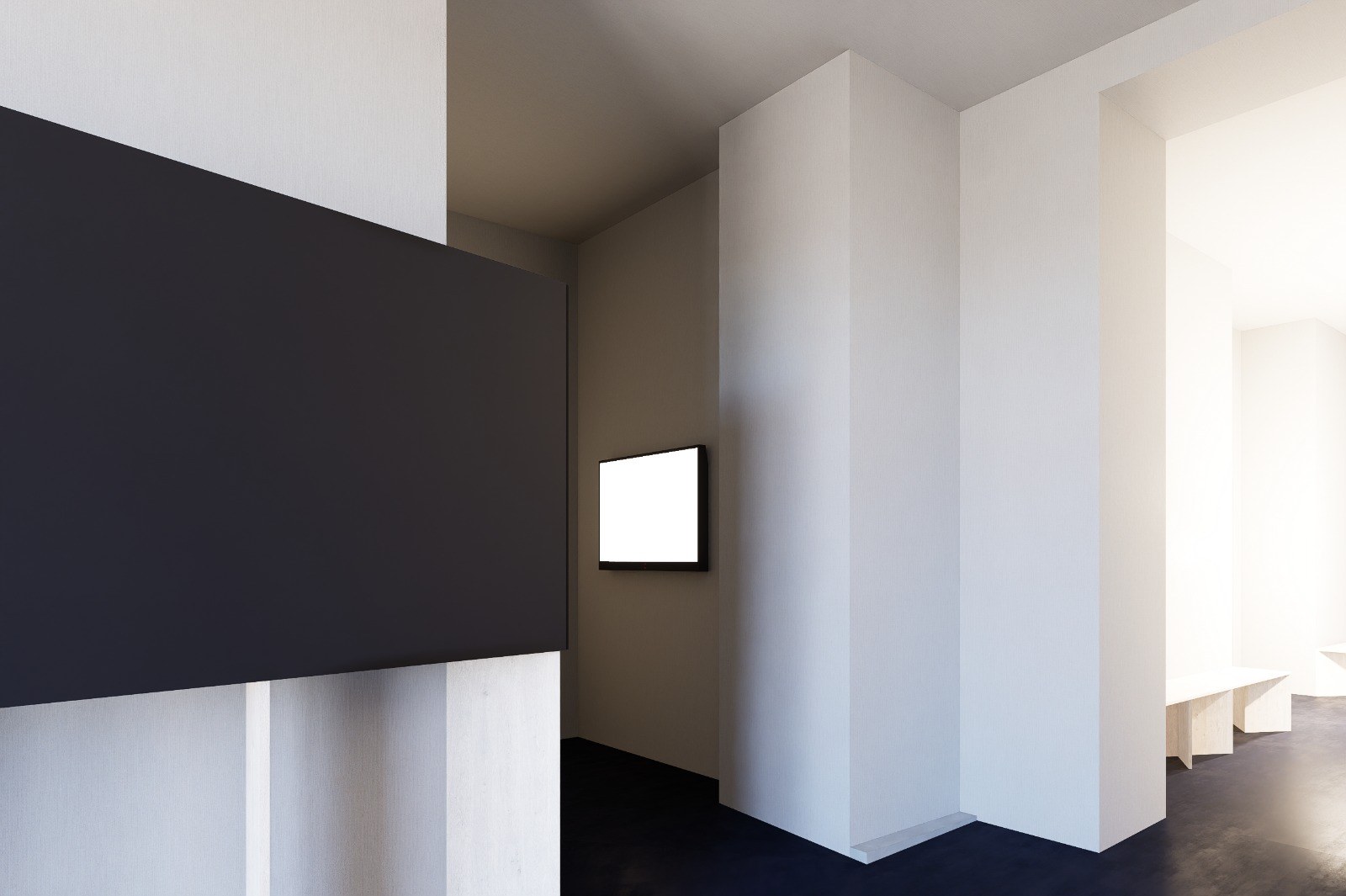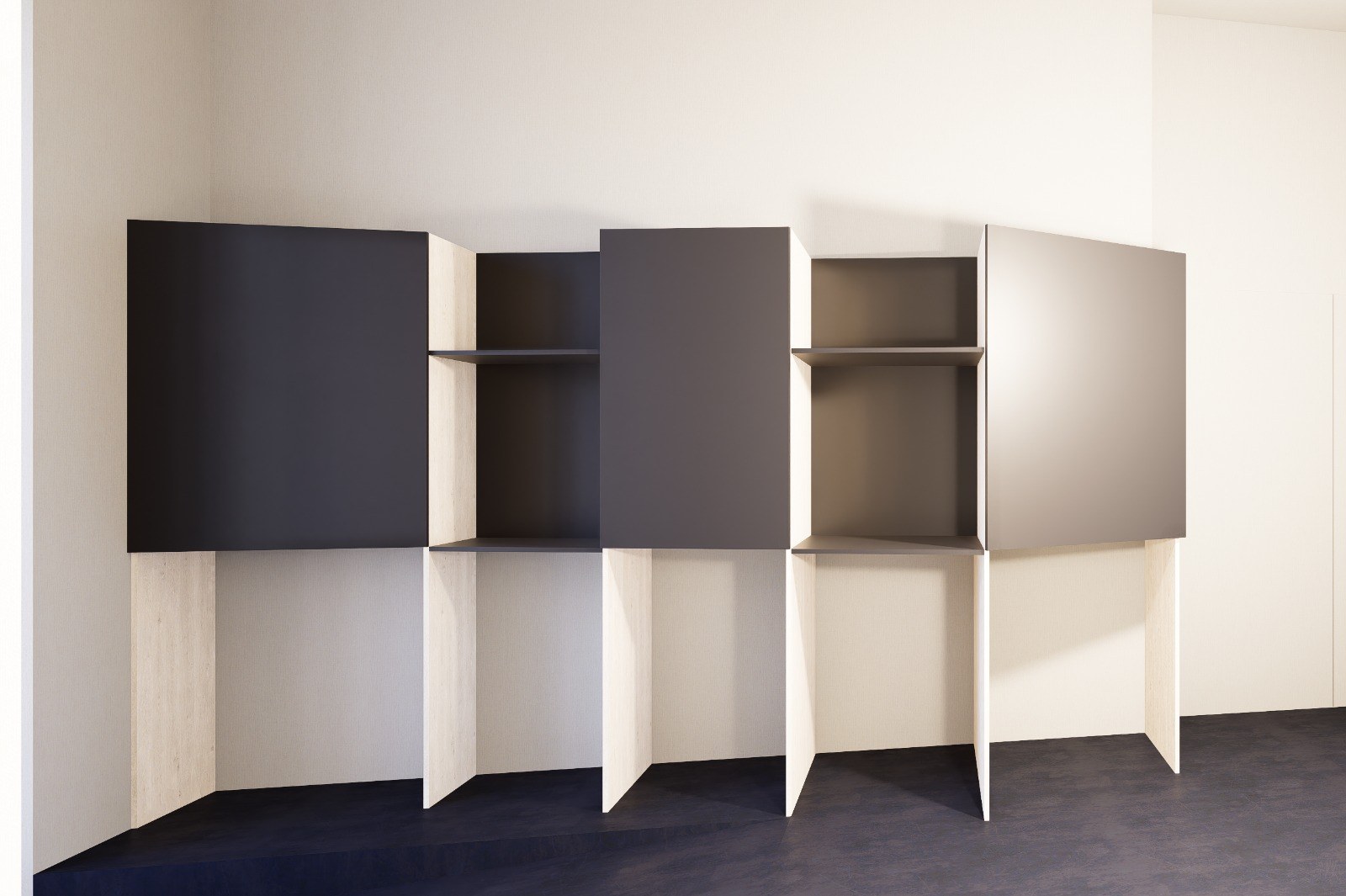Amo Salon Ausstellungsraum (Amo Salon Exhibition Space)

Foto: Heike Zappe, spring 2025
Intro
Der gemeinsame Eingangsbereich des Instituts für Europäische Ethnologie (IfEE), des Berliner Instituts für Migrations- und Integrationsforschung (BIM) und des Georg-Simmel-Zentrums für Stadtforschung (GSZ) bietet vielfältige Ausstellungsmöglichkeiten.
***
The IfEE Amo Salon Exhibition Space is located in the entrance area of the Institute for European Ethnology (IfEE), the Berlin Institute for Migration and Integration Research (BIM), and the Georg Simmel Center for Urban Research (GSZ). Designed as a dynamic interface between the university and the public, the Amo Salon Exhibition Space offers a versatile setting for exhibitions, events, and collaborative projects.
Forschung und Lehre am IfEE, dem BIM und dem GSZ verfolgen das Ziel, Brücken zu gesellschaftlichen Akteur*innen zu bilden. Der Amo Salon Ausstellungsraum (ASA) ist ein wichtiger Bestandteil unserer Idee von öffentlicher und kollaborativer Forschung. Der Ausstellungsraum ist nicht nur Ein-, Aus- und Durchgang, sondern auch ein Raum der Zirkulation zwischen Innen und Außen. Der Ausstellungsraum bringt den Amo Salon, den GartEEn, die Straße und Nachbarschaft zusammen und bildet ein lebendige Verbindung zwischen dem Institut und der Stadt, sowie der Universität und der Öffentlichkeit. Der Ausstellungsraum steht Studierenden, Forscher*innen, Nachbar*innen und der Öffentlichkeit gleichermaßen offen.
Der Amo Salon Ausstellungsraum ist verbunden mit dem Amo Collective des IfEE, einem Kollektiv aus Forschenden, Künstler*innen, Nachbar*innen und anderen Akteur*innen. Das Amo Collective formierte sich aus den Kämpfen um die Umbenennung der M*straße in Anton-Wilhelm-Amo-Straße und steht für eine öffentliche, eingreifende, aktivistische, aber auch kreative, experimentelle und multimodale Forschungspraxis.
Der Amo Salon Ausstellungsraum ist in zwei Bereiche unterteilt.
Der Kernbereich des Raumes behandelt die fortdauernde Geschichte des Straßennamens. Er widmet sich dem Leben und Vermächtnis von Anton Wilhelm Amo, dem neuen Namensgeber der Straße, und zeigt ein von Mitgliedern der Black Student Union der HU kollaborativ gestaltetes Portrait von Anton Wilhelm Amo.
Der temporäre Ausstellungsbereich steht der Nutzung durch eine Vielzahl von Personen und Projekten offen und kann für wechselnde Ausstellungen, z.B. aus Projekten, Lehrveranstaltungen, oder auch anderen Kontexten genutzt werden. Das dynamische und modulare Ausstellungsdesign schafft Raum für die Präsentation unterschiedlicher Projekte und ermöglicht eine multimodale und experimentelle Herangehensweise.
Weitere Informationen und Nutzung
Sofern Ausstellungen thematische Verbindungen zur aktuellen Lehre aufweisen, binden wir sie gerne in Form von Gastbeiträgen oder Diskussionen in Seminaren ein. Im aktuellen Vorlesungsverzeichnis finden sich mehr Informationen.
Das IfEE bietet darüber hinaus verschiedene Ressourcen an, die sich für Ausstellungen anbieten. Es gibt einerseits mehrere Archiv- und Sammlungsbestände des Instituts, die von der Berlin-Brandenburgischen Landesstelle für Alltagskultur verwaltet werden und gerne konsultiert oder genutzt werden können. Einige der Bestände sind auch Teil der wissenschaftlichen Sammlungen der Humboldt-Universität zu Berlin, deren Konsultation wir nahelegen. Das Amo Living Archive sammelt ebenfalls Materialien aus der (rezenten) Geschichte des Instituts und des Amo Collectives.
Die Veranstaltungsräume des Instituts sowie der Amo Salon bieten sich für Eröffnungen und Gespräche an. Informationen zu Veranstaltungen und Ausstellungen kommunizieren wir gerne in Kooperation auf unserer Website, sozialen Medien und Newsletter.
Die Ausstellungen sind während der Öffnungszeiten des Instituts (wochentags von 8-18h) öffentlich zugänglich und in Absprache, z.B. für Sonderveranstaltungen oder zur Vorbereitung, auch länger.
Mehr Information zum Re/Arrangement des Erdgeschosses des IfEE gibt es hier:
https://coopdisco.net/projects/um-ordnung-ee/
Kontakt: exhibition.ifee@hu-berlin.de
Ausstellungsteam: Magdalena Buchczyk & Jonas Tinius
Credits
Der Raum wurde kollaborativ möglich gemacht durch die Unterstützung von:
Kuration: Melanie Garland
in Kollaboration mit Mitgliedern des Amo Collective: Magda Buchczyk, Carla J. Maier, hn. Lyonga, Ingri Pavezi, Nicole Pearson, Regina Römhild, Adela Taleb
und der Unterstützung von Alejandra Atalah, Paula Kaniewska und Eryn Staiblin
Ausstellungstexte Kernbereich: Melanie Garland, Carla J. Maier und Magda Buchczyk
Begleitheft: IfEE scholars (Übersetzungen: Flora Ohlberger)
Gestaltung von Plakat und Cover des Begleitheftes: Imad Gebrael
IfEE Poster: Elisabeth Luggauer & Imad Gebrael
Ausstellungsdesign: coopdisco
Weiterer Dank: Ignacio Farias, Carsten Hoch, Romy Klecker, Felix Marlow, Eduard Vollmer, Daniela Weber, sowie allen Studierenden und weiteren Mitarbeiter*innen, Künstler*innen und Mitgliedern der Zivilgesellschaft.
At Anton-Wilhelm-Amo-Str. 41, research and teaching are guided by a commitment to connecting academic work with broader society. The exhibition space regularly hosts a wide range of projects and actively encourages creativity and experimentation. It serves as a vibrant membrane between the university and the city, fostering dialogue and collaboration across institutional and social boundaries. The Amo Salon plays a central role in this vision of public and collaborative research. More than just a ground floor space, it is an active part of daily life at the institute—open to students, researchers, neighbors, and the general public.
The Amo Salon is closely linked to the ongoing work of the Amo Collective—a group of IfEE researchers, artists, local residents, and collaborators. The collective emerged from the campaign to rename M*straße to Anton-Wilhelm-Amo-Straße, and stands for a research practice that is public, activist, creative, experimental, and multimodal.
The IfEE Amo Salon exhibition space is divided into two areas:
• The core exhibition space focuses on the ongoing history of the street's renaming. It honors the life and legacy of Anton Wilhelm Amo, the new namesake, and features a collaboratively created portrait by members of the Black Student Union at Humboldt University.
• The temporary exhibition space is available for use by individuals and groups from both within and outside the institute. It can accommodate temporary installations from research projects and teaching initiatives to artist and community collaborations. Thanks to its modular and flexible design, the space supports a wide range of presentation formats and invites experimental, multimodal approaches.
Integration & Resources
We welcome exhibitions that align thematically with the vision of the Amo Salon.
The Institute for European Ethnology (IfEE) provides a range of resources suitable for exhibition projects. These include several archives and collections managed by the Berlin-Brandenburg Office for Everyday Culture, which are available for consultation and use. Some of these materials are also part of the scientific collections at Humboldt-Universität zu Berlin, which we encourage you to explore. In addition, the Amo Living Archive offers resources related to the recent history of the institute and the Amo Collective.
Our event spaces—including the Amo Salon—are available for exhibition openings and public discussions. We are happy to collaborate in promoting exhibitions and related events through our website, social media channels, and newsletter.
Exhibitions are open to the public during the institute’s regular hours. Extended access can also be arranged, for example, in conjunction with special events.
More information on the re/arrangement of IfEE’s ground floor can be found here:
https://coopdisco.net/projects/um-ordnung-ee/
Contakt: exhibition.ifee@hu-berlin.de
Exhibition Team: Magdalena Buchczyk & Jonas Tinius
Credits
The space was collaboratively made possible through the support of:
Curation: Melanie Garland
In collaboration with members of the Amo Collective: Magda Buchczyk, Carla J. Maier, hn. Lyonga, Ingri Pavesi, Nicole Pearson, Regina Römhild, Adela Taleb
and in assistance with Alejandra Atalah, Paula Kaniewska and Eryn Staiblin
Exhibition texts in the permanent area: Melanie Garland, Carla J. Maier and Magda Buchczyk
Accompanying booklet: IfEE scholars (translations by Flora Ohlberger)
Poster and booklet cover design: Imad Gebrael
IfEE poster: Elisabeth Luggauer & Imad Gebrael
Exhibition design: coopdisco
Further acknowledgements: Ignacio Farias, Carsten Hoch, Romy Klecker, Felix Marlow, Eduard Vollmer, Daniela Weber, sowie allen Studierenden und weiteren Mitarbeiter*innen, Künstler*innen und Mitgliedern der Zivilgesellschaft. / Special thanks to Ignacio Farias, Carsten Hoch, Romy Klecker, Felix Marlow, Eduard Vollmer, and Daniela Weber, as well as all students and further researchers, artists, and members of the public.



Um eine Ausstellung im Amo Salon Ausstellungsraum vorzuschlagen, füllen Sie bitte dieses Formular aus und senden Sie es an exhibition.ifee@hu-berlin.de.
Das IfEE-Exhibition-Team prüft eingereichte Vorschläge innerhalb von drei Monaten und wird Sie kontaktieren, falls weitere Informationen erforderlich sind
***
If you would like to propose an exhibition at the Amo Salon Exhibition Space, please fill out this form and send it to exhibition.ifee@hu-berlin.de.
The IfEE exhibition team will review submitted proposals within three months and will contact you if further information is required.
[Ausstellungsdaten (Titel, Laufzeit)]
[Fotos]
[Exhibition dates (title, duration)]
[photos]
